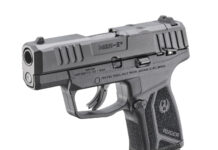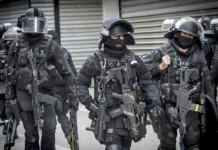The G36 was the reunited Germany’s NATO rifle, their admittance back into “the good guys” in full with a modernizing defense force. In the 90’s where it was developed it was a technological marvel, to nearly the same degree as the AR-15 was back in the 60’s with its extensive use of aluminum. The polymer construction and a profile fit for sci-fi didn’t hurt its appeal at all either.
The G36 has faults, all platforms do, but one fault it did not have was the hearsay that led to the 2015 decision to replace the rifle in German service. The rumor that the G36 rifle is ‘inaccurate’ when a couple magazines have been put through it. This has been disproven by multiple independent tests and several theories have been brought forward to explain the phenomenon that german troops claimed to have experienced within the anecdotal evidence. This didn’t change the G36’s fate, and maybe it was time for an update.. but the reason was false.
The anecdotal claims were used to deride the G36 until the Bundeswehr said they would “upgrade” their carbines. The problem they’ve found is that the G36 was built well enough that the new rifles aren’t outperforming the old one by that great a margin… and aren’t hitting a rather ludicrous accuracy requirement.
Where have we heard these things before?
These claims parallel similar motivated attacks against the M4 by Robert Scales, a retired US Army General. Scales led a vicious campaign against the M4 Carbine. I believe Scales was more ideologically motivated than the elements in Germany were, but that doesn’t change the fact that both sources were using suspect and faulty data to support canning the rifles.
Tests of both platforms have shown they work well.
The attack on the G36 was anecdotal accuracy while the attack on the M4 was anecdotal reliability. Scales famously and loudly proclaimed the M4 jamming caused the deaths of several soldiers under fire in Afghanistan. A review of the battle found that was simply an absurd claim, the weapons that went down during that prolonged firefight were belt-fed machine guns and the casualties taken by US forces were the result of effective enemy action, not equipment failures. Soldiers can get killed in firefights, just because a soldier had an M4 with a red dot on it instead of a SCAR with an LPVO doesn’t mean the conscript goat herder with the Mosin Nagant firing rounds in that soldier’s general direction can get a hit that misses the soldiers plates and wounds or kills them.
Now, all things being equal, there are rifles, like my favorite FN SCAR, that are academically more reliable, in the notorious “Dust Test” the M4 had a stoppage rate of 882/60,000 with 863 being soft stoppages that were easily cleared with continued function. That reported rate was also an outlier in the test and in other iterations the M4 performed much closer to the other rifles, magazine also accounted for a high rate of failures with 239 attributed.
The SCAR, in comparison had a stoppage rate of 226/60,000, which is roughly a 4 times improvement. But from a different perspective the M4, at its worst extreme outlier failure rate, was 98.5% effective while the SCAR was 99.6%. The SCAR, from this wider view, is only 1.1% more reliable and the H&K 416 about the same. The H&K XM8, a wild variant of the G36 for the US Army back in the early 2000’s, actually performed the best with 127/60,000 or 99.78% reliability.
In 1990 the standard for M4 reliability was 1:600 (99.83%) mean (average) rounds between failure given normal operating conditions (the dust test was an extreme operating condition) the standard in 2013 for the M4A1 was 1:1,691 (99.94%). In practical terms that meant a soldier would have to fire 3 full combat loads (210 rounds, 7 magazines, standard combat load) before likely experiencing 1 stoppage in a 1990’s M4, and today would have to fire 8 full combat loads.
We are magnitudes ahead of when auto-loading rifles first entered US hands as a standard, the M1 Garand’s rate was only 1:9 (87.2%) when it was chosen to replace the M1903 in 1940 (USMC). 80 years later we are at the razor’s edge of reliability where we are talking tenths and hundredths of a percentage difference.
What was probably most illustrative about all the the trials worldwide since the turn of the century is that we’ve largely maxed the 5.56x45mm cartridge and its competitors. All these designs work well when built well, AR, SCAR, AK, XCR, X95, G36, etc. The limits are largely imposed by where on the diminishing returns curve a particular group wants to sit. Does a 2 MOA or 1.75 MOA choice matter for a rifle that’s extreme range is 600 meters, practical is 300-400 meters, and is it worth $200, $400, $1,000 per unit cost to implement?
New Systems – NGSW
The new NGSW rifle system, to include optic, is supposed to push effective ranges of the fighting rifle to 1,000 meters. We had to change calibers to do that. But given some quick and dirty math the new rifles won’t be drastically more accurate than today’s rifles, they will just have a caliber that can reach the distance. The M110 is held to 1.1 MOA accuracy which should produce a roughly 12″ group at 1,000 meters if the .308 had the legs to get there consistently. The new 6.5 Creedmoor’s should make that much easier.
Given current combat rifle accuracy standards (maybe even pushing them a little because we can) we could ask for a 90% hit probability at 1,000 meters of the NGSW rifle. Target size is an 18″x30″ (torso) hit zone and we end up with a rifle and ammunition combination that we are asking… about 1.5-2 MOA out of.
[ The Dirty Math: 18″ is 90% of a 20″ hit zone. Set that 20″ hit zone at 1,093.6 yards/1,000 meters. Given the ‘1 MOA is 1″/100 yards’ we divide our 20″ hit zone (which would give an over 90% hit rate based on the 30″ vertical target area) by the 1,093.6 yards to get .0182″/yard or 1.82″/100 yards. 1.8 MOA, the round just has to be able to get down range that far without suffering too many environmental impacts to its accuracy. The two most drastic of those impacts in the control of shooter/user/manufacturer is when the round crosses from supersonic to subsonic and the ballistic coefficient of the projectile to mitigate atmospherics.]
So ultimately this is a situation we have already been able to consistently build as an industry in shorter legged calibers with proper projectiles. 77gr 5.56x45mm rifle/ammo combinations have routinely been able to offer shooters this performance envelope. I’m very interested to see where the NGSW program lands us and what performance rounds like the .277 Fury with an advanced optic suite like the NGSW-FC will actually allow an end user to do and how much more easily. With things like active range/cant reticle adjustment and active atmospherics reticle adjustment we should be vastly increasing first round hit probability… assuming the user can shoot worth half a damn.



